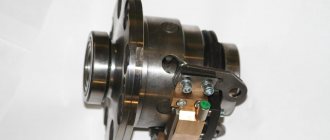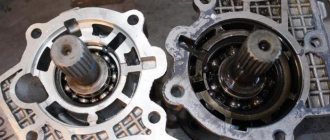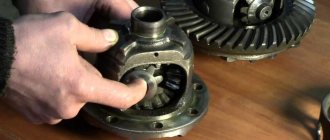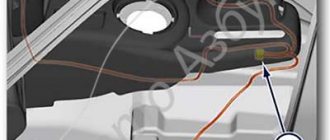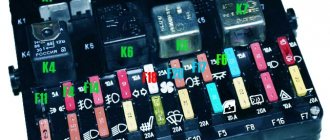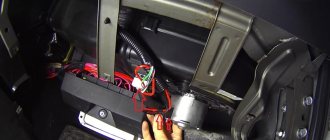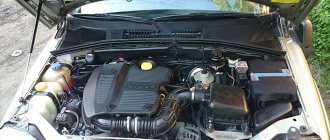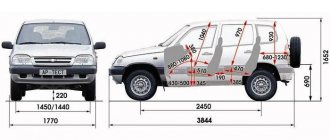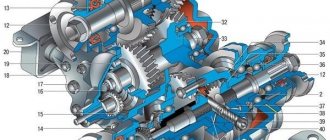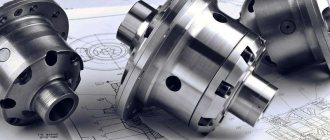Differential lock in Shevik - I didn’t know, but in vain
Hello everyone, I'm back in touch and today I have an important topic for you about blocking.
I admit, I have never drilled in severe off-road conditions, and therefore have never even used a lock. And in general, until recently, I had a vague idea of what other positions there are in the transfer case besides low gear and why are they needed. But today I saw with my own eyes how the Chevy Niva was slipping on the ice and only 1 wheel was spinning - the one that was slipping. All the other wheels just stood there, not spinning. For me, to be honest, it was akin to a revelation, I would never have thought that this could happen, I personally thought that all the wheels of the Niva and Shevik always spin. A naive young man, to be sure)) But I’m still just starting to master my Chevy Niva and am learning everything I didn’t know.
And then the driver engages the standard lock and, lo and behold, the front axle, one front wheel also began to spin and the car drove off the ice hill without any problems.
Just like that, I thought, and when I came home, I sat down to study the materiel, which I will share with you.
Transfer case - lowering and locking
If you don’t know how to use the transfer case, where everything is turned on, then here you go, clearly with a photo. Immediately learn to turn on the lowering and locking. And not thoughtlessly, but at the right moments.
So, by default, on Niva and Shevik, in the transfer case you can turn on not only a low gear, but also add a center differential lock to it. In the example above, everything became clear how this locking works - if at least one wheel is stuck, then without locking the maximum is given to it - all the torque goes to this one wheel. All 100 percent. By turning on the lock, we transmit torque to another axle (another axle - front or rear). So thanks to it, the car sometimes very often copes not only with ice, but also with off-road conditions - liquid mud is akin to ice, as soon as the wheel starts to slip - all the momentum goes to it and the car stops. We turn on the lock, the wheels of the other axle begin to spin and the car starts to move.
However, what to do when other wheels begin to slip? Then screw it, you won’t go anywhere. This is called diagonal hanging, and in this case only inter-wheel locking will help. I think the meaning is clear - the torque is already transmitted from the right wheel that has stalled to the left one and vice versa. So to speak, the car becomes even more improved.
Inter-wheel locking is most often done by installing self-locking differentials, which can be installed in the front and rear axles, or in two at once if you are a fan of off-road conquest. Their short name, which everyone knows, is self-blocks. There are automatic and forced. Prinudilovo is, of course, cooler, but probably more complicated and more expensive.
What kind of self-blocks are these?
I googled and found out that most often they are installed by two manufacturers - DAK and Val Racing, Daki - most often installed on UAZ of all types, and "Val Racing" can be installed on Niva and Niva Chevrolet - the option is simply ideal.
The principle of operation is exactly the same as that of the center lock, only here the moment is transferred between the wheels - that is, the right wheel slips - the automatic lock is activated (DAK and Racing - they are automatic) and the moment is transferred to the standing left wheel. Inter-wheel locks help a lot in getting out of ruts when, as a rule, 1 wheel out of two on the same axle slips.
Everything looks simply gorgeous and I immediately wanted to install Val Racing. However, having learned the price - 10,000 rubles per set (2 pieces), plus the installation of 4-5 thousand, in total the installation of such self-blocks on one bridge already amounts to 15k. I’ll save up, it’s a mega useful thing in my opinion.
Most often they install a block on the rear axle, however, as the pros say, installing self-blocks on the front axle increases cross-country ability more noticeably than on the rear axle. However, here the controllability deteriorates and other other troubles up to an increased load on the auxiliary suspension elements. Nothing passes without a trace))
So if you haven’t used a lock on your Chevy Niva before, be sure to try it when you find yourself in liquid mud. It is strictly forbidden to use the center wheel on a regular highway/asphalt, only off-road.
Well, if you at least sometimes go off-road for fishing, hunting and picnics, then install normal mud tires. Do I often see Sheviks on road tires in the city? For what? Why put regular tires on a Chevy Niva? Chevy is designed to drive in rural areas, but driving such a car purely around the city is nonsense. It consumes a lot of gas in the urban cycle. Therefore, if you are already interested in blocking, then the rubber must be toothy. Of the imported ones, I recommend, of course, Goodrich (if you have a lot of money), Kumho or Hankuk (if you have less money), and if you’re short on money, then only Cordiant Offroad or the Kirov K-139.
What is a differential and what is it used for?
The differential has the form of a mechanical installation with a set of planetary gears and shafts. It is designed to distribute torque from the engine of a Chevrolet Niva car to the drive wheels, which are mounted on the same axle. This allows the wheels of the car to spin at different speeds. Rotating the wheels at different speeds is very important when turning a car, when one wheel passes a small radius and the other a large one. In the absence of a cross-axle differential, this would lead to spinning (slipping) of the wheel, which covers a smaller radius. A single wheel slipping would cause the vehicle to skid and increase tire wear.
When a car moves in a straight line at a constant speed, then the thrust from the engine to the wheels is distributed evenly. This helps both drive wheels rotate at the same speed. When one of the drive wheels slips, the differential automatically distributes the traction force from the engine. At the same time, the force on the slipping wheel increases and decreases on the stationary one. Typically, cars have only one differential installed in the drive axle. There are three of them installed on Shevik:
- Two differentials are installed in the front and rear axles of the car, which allow the drive wheels to rotate on the same axle at different speeds.
- The third is central (interaxial action). It helps distribute torque from the engine to both axles of the vehicle.
Chevrolet Niva differential lock
SUVs, including the Niva, have the ability to lock all three (cross-wheel locks are installed optionally) differentials. Thus, the vehicle’s maneuverability in harsh off-road conditions increases many times over.
When one wheel of the car slips, through the differentials, traction force will be transmitted from the engine to this wheel. All other wheels will be at rest, since the traction force will not act on them. Thus, the car will be immobilized. For example, while one wheel is slipping in a hole, the remaining wheels will be at rest. This means that all the traction force will be transferred specifically to the slipping wheel and will contribute to its rotation.
The purpose for which forced differential locking is turned on is to unite the drive wheels with each other, while ensuring their rotation at the same speed. Blocking makes it possible to make maximum use of the traction force transmitted from the car engine.
The operating principle of the differential lock on a Chevrolet Niva. As you know, a differential consists of gears and shafts, which make it possible to automatically distribute torque from the engine to the wheels. Forced differential locking prevents the gears from rotating, which is achieved using a special locking clutch. Thus, when the lock is manually engaged, the driving wheels of the car are rigidly connected to each other. This connection allows the wheels to rotate at the same speed. When the center differential lock is engaged, the drive shafts of the front and rear wheels are rigidly connected to each other, thereby providing uniform torque to the front and rear axles. The vehicle's cross-country ability increases, which makes it possible to be the first of its kind in SUVs. When the traction of the car's wheels is better, the more traction power the car will receive.
When is it necessary to use a differential lock?
Not all cars have the ability to lock the differential, which makes these cars more vulnerable off-road. And sometimes it happens that now it would be useful to have two axles on a car. The Chevrolet Niva is a unique car that has great cross-country ability on all types of off-road and even mountain surfaces. Forced blocking is used in the following cases:
- When the vehicle overcomes difficult road sections. The blocking is activated prematurely, before entering such a road.
- On steep slopes or mountainous areas where there is a possibility of wheel slip.
- When driving on a dry sandy road.
- When the road is covered with a layer of ice or snow crust.
Do-it-yourself differential lock on Niva Chevrolet
The Chevrolet Niva is one of the few Russian-made SUVs that, in addition to excellent cross-country ability, can also boast a relatively modern design. Therefore, it still enjoys well-deserved popularity in the market.
The Chevrolet Niva owes its good off-road characteristics to its predecessors - the VAZ2121, namely permanent all-wheel drive, with the possibility of forced differential locking. But before setting up the transfer case and using the gearshift levers correctly, you must first understand how this mechanism works and what happens during its operation.
The transmission of this type of car consists of several main components: cardan, gearbox, transfer case and axles. The main component in the bridge structure is the differential. If it were not there, the wheels would rotate at the same speed, which would lead to wheel slipping and excessive load on the axle. The presence of a differential allows you to avoid destruction of the axle due to the fact that when turning, torque is transmitted to one of the wheels.
The design itself provides for the transmission of torque to the wheel, which experiences less traction with the surface. Therefore, for example, a wheel that stands on ice or sand will spin faster than one that stands on asphalt.
The Niva design provides for the presence of three differentials. This is due to the presence of permanent all-wheel drive in the car. If the same force were transmitted to all wheels, then the car could only move in a straight line. But when turning, the forces between the wheels are distributed unevenly. Accordingly, two bridges connected to each other will invariably experience increased loads that can destroy the structure. There are some SUV models that do not have a center differential installed, but they use other technical solutions, such as clutches or all-wheel drive is not permanent.
Rules for using differential
These include:
- Switching the transfer case should only be done when the car is not moving.
- You can also engage the differential while the vehicle is moving.
- You can switch to a lower gear while the car is moving.
- To ensure long-term and uninterrupted operation of the differential, it is necessary to periodically turn it on, especially in winter. This should be done once every 7 days.
Shift lever location
In the interior of the Niva Chevrolet, there are two levers between the front seats . Using one of them you can change gears in the gearbox, and using the other you can control the transfer case.
Differential shift lever
The transfer case is based on a gearbox consisting of two stages . The control lever comes out of it into the cabin. He can move forward or backward. At the same time, it switches on/off downshift. If the lever is moved left or right, it can turn the differential lock on/off.
Gear shift and transfer case diagram
Downshift: what does it give?
The main component of the transfer case is the reduction gearbox . If the control lever is in the rear position, then the number of transfer cases decreases and is 1.2 . When the lever is in the forward position, the gear ratio increases. It will already be 2.1 . When the lever is in the neutral position, the gear ratio is equal to .
The differential is an integral part of the all-wheel drive mechanism in any car. It is recommended to use it only when the car is moving off-road.
What is forced differential locking?
It is only necessary in cases where, for example, only one of the 4 wheels will rotate. For example, when hanging horizontally, one wheel will be raised and maximum torque will be transmitted to it. In this case, all-wheel drive will be automatically disabled. Therefore, a forced differential lock is installed on the Niva. But it should only be used in off-road conditions. You can turn it on by moving the small lever forward.
The changes introduced by the American concern GM to the transfer case turned out to be quite minor. But at the same time they radically changed its structure. Compared to the old Niva, the need for an additional lever has disappeared and there are only two of them left. The modified location of the transfer case supports made it possible to reduce the vibration load on the body, thereby significantly reducing the noise level from the transmission.
Turning on all-wheel drive.
The use of blocking will be justified in the following cases:
- If there is a possibility of wheel slipping, in areas with poor surface conditions,
- If there is a lack of engine thrust at high speeds,
- When driving on roads with loose surfaces, snow, ice.
You should also take into account some features of the Chevrolet Niva, namely, the helplessness of the transmission when hanging diagonally. In this mode, the wheels begin to spin, so if necessary, you need to dig under the wheel or make an embankment under the raised axle.
Many car enthusiasts like SUVs due to their high maneuverability in difficult terrain. Among domestic cars, a striking example is the Chevrolet Niva brand. And in order for the car to be able to overcome hard-to-reach obstacles, you cannot do without differential locking on the Niva. Regardless of the brand of SUV, including the aforementioned Niva, all cars have one characteristic feature, which is the presence of all-wheel drive and differential. More detailed information is provided below.
Differential lock
Forced blocking not only complicates the design but also automatically makes it more expensive and less reliable. But if you install a differential lock yourself, this is usually caused by the desire to replace the standard differentials with a forced locking mechanism. This can negatively affect the operation of the transfer case, so it is necessary to select those parts that will be compatible specifically with the Chevrolet Niva.
At the moment, among the solutions presented on the market, the most popular are those made on the basis of:
- pneumatics
- electronic control
- self-locking
Each of them has both advantages and some disadvantages in operation.
Types of limited slip differentials
Disk. No preload, which means it doesn't have smooth tension. The drive wheels begin to rotate simultaneously, but without tension, all starts will be accompanied by impacts on the steering wheel.
Screw. Unlike a disk one, there is already a smooth tension, which does not affect the steering wheel so much. Such self-locking differentials are often installed on front-wheel drive cars, for example, VAZ 2110.
For the VAZ 2121 SUV, the most popular are DAK and DAN:
DAK (Differential Automatic Krasikov). Belongs to the family of automatic ball differentials and provides full locking and evenly distributes the load. According to reviews, its service life is reduced when operating without load, and a hum may appear. An excellent option for installation in a plug-in bridge.
DAN (Nesterov Automatic Differential). This continuation of the DAK allows not only to differentiate the angular speed of the driving wheels of the car during its maneuvers, but also to gently redistribute torque from the engine to the driving wheels.
Self-locking system
Can be configured to the required switching threshold. This can be either a slight slip or uneven distribution of torque among the wheels. Such a connection is not rigid, and therefore does not place unnecessary load on the interaxial connection.
When installing a forced locking system on a Chevrolet Niva, you should remember that a constantly turned on system can put unnecessary stress on the transmission, so you should turn it on only when overcoming difficult sections of the road.
Types of blocking
If you want to install a locking mechanism on a differential, you should know that there are two types:
- full blocking;
- partial blocking.
Full blocking mechanisms can operate manually (forced differential locking on the Niva) or automatic mode, while partial blocking is carried out only automatically. Just don’t forget that driving a car with a full lock on a good road leads to premature tire wear. In addition, some parts also fail quickly.
Thus, the whole choice comes down to which mechanism to choose: manual or automatic. The manual system has one advantage - the driver himself decides whether to engage the differential lock or not. However, there are also a number of disadvantages:
- to activate the system, you need to remove your hand from the steering wheel;
- It is imperative to disable the lock in a timely manner, otherwise the chassis of the vehicle may be damaged;
- high price.
The automatic differential lock on the Niva has its own characteristics, among which is the need to customize it to the individual driving style of the car owner. At the same time, the mechanism does not load the car’s transmission as much as its manual counterpart. The system provides complete comfort for the driver, since, if necessary, it is activated without human intervention.
It also all depends on your driving style. For those drivers who prefer a quiet ride on a flat road surface, it is better to opt for a viscous coupling or a disc clutch. In case of extreme driving style, you cannot do without a forced differential locking system on the Niva.
Forced blocking on Niva and Chevrolet Niva: advantages over self-blocking
The reason for the popularity of the Niva and Chevy Niva is that they are equally comfortable to drive both on public roads and off-roads of varying difficulty.
However, different operating conditions also place different demands on a vehicle's transmission.
In off-road conditions, it may be necessary to transmit torque to both wheels, which is why the differential lock is used.
But as soon as you leave the dirt on the usual asphalt, the differential must be unlocked again.
This is where forced blocking of Niva comes to the rescue.
The main advantage of this type of locking over the so-called self-locking differentials (self-locking differentials) on the Niva is that the process of controlling the locking mechanism becomes completely controllable.
You simply press the differential lock on/off button when the need arises, thereby fully controlling the operation of the locking mechanism.
The locking mechanism is driven by a pneumatic drive, the operating diagram of which we described in the review of forced locking for UAZ Spicer Bridge vehicles:
Types of differentials
Depending on the type of gears used, the differential can be:
The cylindrical mechanism is mainly installed on cars with all-wheel drive. This is where the differential lock on the Niva would come in handy.
A bevel differential, usually symmetrical, is placed between the wheel drives.
Worm torque transmission is quieter than its analogues, but has a more complex design. It is a universal option, since it can simultaneously be an inter-wheel and inter-axle differential.
Also, the differential can be symmetrical or asymmetrical, depending on the number of teeth.
Advantages of forced blocking from IZH-TECHNO
What are the advantages of our forced blocking over existing analogues?
Forced locking kit
- The first, important point is the ease of installation and the availability of all the necessary components for installation . The differential assembly with our lock is installed in its standard place in the axle gearbox. You do not need to somehow “finish” the gearbox or purchase additional spare parts such as claw couplings or original axle shafts. Our locking is compatible with original axle shafts. All you need to install it is a standard set of plumbing tools. No “exercises” with a welding machine and grinder.
- Our locking system consists entirely of original components produced by IZH-TECHNO. Therefore, we guarantee the high quality of its individual components and locking elements; In turn, the high quality of components is a guarantee that you will not need any spare parts throughout the entire service life of the product, because there is simply nothing to break in it.
- We paid special attention to such a parameter as the strength of the satellite group . This is no coincidence: after all, it is she who transmits torque to both wheels of the axle and experiences the highest loads. The strength of the satellite group is confirmed by a series of tests carried out both in laboratory conditions and in real off-road conditions.
The lock has four satellites instead of the standard two
- The blocking has four satellites , instead of the standard two. This design allows for even distribution of torque and is more reliable than stock. We paid special attention to the parameters of the satellites themselves, increasing the thickness and height of the splines (see photo below):
On the left is a stock satellite, on the right is a satellite produced by IZH-TECHNO
- Protection of the pneumatic drive of forced blocking. The pneumatic drive is hidden inside the axle housing and is protected from mechanical influences; it cannot be broken or damaged.
- The differential housing is manufactured with high precision and strict tolerances , which ensures the absence of vibrations and noise in the axles when driving on the highway.
Niva differential housing cover
- Speed of blocking . By increasing the number of teeth involved in the differential locking, we achieved quick response of the locking mechanism. You don't have to wait for the wheel to rotate to 120 degrees for the system to finally work. In our case, 9 degrees will be enough.
- Versatility . The lock is suitable for all modifications and variants of Niva and Chevrolet Niva cars; it can be installed in both the rear and front axles, in both steel and aluminum front axle gearboxes. Locking options for 22 and 24 splines are available.
Read more about the features of forced blocking on Niva and Chevrolet Niva in the description on our website.
Transmission
The Chevrolet Niva gearbox has no structural differences compared to the Lada 4x4 box, and they are identical in design. The difference can only be noticed in the mounting and length of the gear shift drive. Another important feature is the presence of 5th gear.
The main parameter of the gearbox is the gear ratio. By trivial definition, this is the ratio of the number of teeth of the driven shaft to the number of teeth of the drive shaft. Naturally, we talk about the gear ratio when there is actually a transfer of torque from one shaft to another. If the specified parameter is greater than 1, then such a mechanism works to increase torque. The gear ratio for IV gear is 1, and for V – 0.82. That is, in V gear there will be an increase in the number of revolutions of the secondary shaft with a parallel decrease in torque. It is more convenient to imagine the value of the gear ratio using the sprockets of a high-speed bicycle.
Cross-wheel differential and its connection with Chevrolet Niva axles
Experts say that the cross-axle differential is the basis of each drive axle of a given vehicle. This is due to the fact that in the absence of a Niva differential device, Chevrolet could only drive in a straight line. The explanation is as follows: when making a turning movement, wheels connected by one axle travel different distances. With a rigid axial fastening, one of them will definitely begin to slip. In addition, the load on it will be prohibitive.
Experts have developed a device that helps to avoid troubles with wheels while the entire vehicle is turning. It's called a cross-axle differential. A differential device is installed between the wheels connected by one axle. The main function of the differential is to distribute possible forces to one wheel.
On the Chevrolet Niva SUV, three cross-wheel differential devices are installed at once:
- the first cross-axle one is on the front axle;
- the second cross-axle - on the rear axle;
- the third interaxle is placed in the transfer gearbox.
The cross-wheel differential distributes traction force to the vehicle's axles so that it can make turning movements in any direction.
What is the purpose of blocking?
This mechanism contains shafts and gears. The differential is intended to distribute torque from the engine to the wheels. In Niva, the main driving wheels are the rear ones. With the help of a differential, the wheels can spin at different speeds , for example, when cornering. In this case, one wheel travels a small radius, and the other – a large one. If there were no differential, the wheels would begin to slip, which would cause increased tire wear.
When driving on a straight road, the thrust from the engine is distributed evenly between the wheels. If one wheel starts to slip, for example on ice, then the differential transfers more force from the engine to it. This mechanism is mainly installed on the drive axle. Niva has it at:
- Rear and front axles.
Video about how the cross-axle differential lock works on a Niva Chevrolet
Forced blocking of the Chevrolet Niva cross-axle differential
The Chevrolet Niva SUV is equipped with a forced locking of the cross-wheel differential device.
Thanks to this mechanism, the driver will be able to take advantage of the capabilities of the blocking process and equalize the speeds of both axles of the car. In this case, only one wheel will spin on different axles of the bridges. Such rotation can increase the vehicle's maneuverability in difficult road conditions. The nuance is as follows: the use of forced blocking of the differential device is allowed only in off-road conditions.
How does a differential work?
During the linear movement of the car, its axle shafts, and therefore the wheels, rotate at the same speed as the drive shaft with its helical gear. But during a turn, the load on the wheels becomes different (one of them tries to spin faster), and due to this difference the satellites are released. Now the engine energy passes through them, and since a pair of satellites are two separate, independent gears, rotation speeds of different magnitudes are transmitted to the axle shafts. Thus, the power generated by the engine is distributed between the wheels, but unevenly, and depending on the load acting on them: what moves along the outer radius experiences less rolling resistance, so the diff transfers more energy to it, spinning faster.
There is no difference in how the center differential and the cross-axle differential work: the principle of operation is similar, only in the first case the distributed torque is directed to the axles of the car, and in the second - to its wheels located on the same axis.
The need for an inter-axle differential becomes especially noticeable when the vehicle is moving over rough terrain, when its weight puts pressure on the axle that is lower than the other, for example, on an uphill or downhill slope.
Types of cross-wheel differential devices
The Chevrolet Niva SUV is equipped with standard cross-wheel differential devices that do not require forced blocking. But the designers foresaw this and produced several types of differentials with a built-in forced locking mechanism. They can also be installed on an SUV such as the Chevrolet Niva.
Among such differential devices, the following types are very popular today:
- With a pneumatic type connection - using compressed air (the blocking is controlled by the driver from the car interior using a silicone hose).
- With an electrical connection - using a cam mechanism (the locking is activated using electromagnets).
- With self-locking (their peculiarity is that they are not controlled by the driver).
Auto mechanics warn that the positive locking mechanism installed on the differential device can excessively exceed the loads on the axle shafts and transfer case. Because of this, failure of both the axle shafts and the transfer case is possible.
Replacing the differential bearing
Replacing bearings for VAZ 2110
Well, we’ve come to the differential, which should also be removed from the box. Next we do the following:
remove the side gears from the differential by turning the satellites 90 degrees;
Differential VAZ 2110
- we take a special puller and remove the retaining ring, which sits in the axis of the satellites (in rare cases, you can use pliers with thin teeth);
- after removing the retaining ring, the satellite axis and, along with it, the satellites themselves will easily come out;
- take a head of the required size and an extension;
- We begin to unscrew the bolts that secure the driven gear to the differential housing;
- after this, the driven gear is removed from the housing (a hammer can be used to remove it).
At this stage, you need to stop and start carefully inspecting the working surfaces of the removed parts. The satellites, side gears, spherical surfaces of the differential housing, etc. are subject to inspection. If small irregularities are found, they should be eliminated with small sandpaper. If the parts have significant irregularities, then they need to be replaced.
Note. In addition, you should carefully check the condition of the driven gear and, if there are chips or other irregularities on it, replace it.
Now you should take a good look at the differential bearing seats. If significant deterioration of these places is noticed, then the housing must be replaced, and if there is pitting (sinks) on the raceways and rolling elements, as well as traces of indentation and damage to the cages, the bearings are replaced. Let's continue:
take a special puller;
Special puller
- press the bearings from the differential;
- then we also press out the outer rings from the gearbox housing.
VAZ 2110 bearing replacement
The outer rings are also pressed out with a puller, but with a different one. If it is missing, then first press out the cuffs of the axle shafts, which are subsequently replaced with new ones. After this, the outer rings are removed using a bit.
Note. There is an adjustment ring under the outer ring. Before pressing in new outer rings, this ring must be re-fitted.
If necessary, we also replace the gear responsible for driving the speedometer (see How to properly repair a speedometer). In this case, you can compress the bearing so as not to destroy it. To do this, take two screwdrivers and apply simultaneous force to the inner ring.
Differential and its installation
The differential, after the bearings are replaced, is reassembled. To make the replacement process go smoothly, it is recommended to use video reviews and instructions, which are abundant on the Internet today. It would not be amiss to look at photos and pictures of suitable ones, because do-it-yourself replacement likes more visual examples. The instructions presented above will ideally help you in your work, as everything is described in detail. Replacing it yourself is a good chance to save on repairs, because the price for it in car services is known to be high.
How to use the cross-axle differential device lock
Before you start using the cross-axle differential locking mechanism, you need to find where the corresponding shift lever is located on the Chevrolet Niva. In the car interior of this SUV, between the front seats - driver and passenger, there are two levers with handles of different lengths:
- the first is for changing gears (it has a longer handle);
- the second is for controlling the transfer gearbox (it has a shorter handle).
Now let's look at the entire process of controlling the blocking process of the cross-wheel differential device.
- As soon as the vehicle enters the off-road lane, it should be stopped.
- Turn on the differential locking process using a lever with a short handle - move it to the left side (if everything is done correctly, the corresponding lamp indicator will light up on the dashboard).
- Drive off-road with the differential lock engaged.
- As soon as the vehicle drives onto a flat road, the lock should be turned off - move the lever with the short handle to the right.
- You can continue moving.
All the described actions for turning on the differential device blocking are effective when the weight is unevenly distributed between the wheels of one axle.
Disabling the differential locking process on a Chevrolet Niva is necessary when driving on a good road. Otherwise, excessive loads on the vehicle transmission will lead to increased fuel consumption and rapid wear of the tires on the wheels.
Experts pay attention to the following nuance: blocking the inter-wheel differential device will not increase the adhesion force of the wheels to the road surface.
Differential operating principle
On the one hand, the differential provides the driver with comfort and safety when driving a car on a hard and dry road surface. On the other hand, everything is not so simple - as soon as you go beyond its limits or get on a slippery surface, the differential makes it impossible for the car to move.
Depending on the situation, the planetary mechanism operates in one of three modes (sometimes differential locking on the Niva is not needed):
- When the car is moving in a straight line.
- When entering turns.
- The car drives through a slippery surface.
Rules for using the cross-wheel differential device lock on a Chevrolet Niva
There are several mandatory rules that should be taken into account when locking the cross-axle differential.
The first rule is related to the specifics of switching the transfer case to lower gears. It is performed by the driver using the appropriate lever only when the vehicle is completely stopped.
The second rule considers the moment when the differential device locking mechanism is activated. Activation is possible when the car is driving without stopping.
The third rule explains how to correctly downshift. This can be done without stopping the Chevrolet Niva.
The fourth rule explains how to ensure optimal functioning of the cross-wheel differential device. The driver of a Chevrolet Niva SUV must periodically make switching movements with the corresponding lever with a short handle on the transfer case. This rule is especially relevant during cold weather in winter. Although experts recommend using the differential lock at least once a week.
A few words about the Chevrolet Niva transfer case
I think it’s time to talk about the transfer case of the Chevy Niva, because those who just bought this car, at the very beginning of use, do not really know how to use the transfer case, what the rules are, and in general, when to lower the gear and when to lock it. Let's figure it out now. It’s a pity, of course, that I didn’t record a video on today’s drive along a fairly washed-out road. Well, never mind, I’ll record it and show it clearly on video. For now, in words.
In general, the transfer case switches to a lower gear, as well as to lock, and it is possible and even necessary to do this at the same time. It’s convenient on the Shevik - this is done with one lever.
Turn it down - right up. Add lock - Pull the lever all the way to the left. Look at the switch handle, it's written there. Letter designation - L(low) - low, N - neutral, H(high) - high, that is, normal.
How inter-axle locking works - read this article. There you will also learn about self-blocks - a real cool upgrade for the Chevrolet Niva, which will allow you to drive even further.
Well, now we’ll figure out when it’s better to turn it down, and when to also lock it. And how to do it correctly.
It looks something like this - we are driving across the field in normal second/third gear. Suddenly there is a terrible puddle ahead. We stop and turn down the car.
This is the first rule - when you engage the lower gear, you must definitely stop, that’s how the Shevik differential is designed. But the lock can be turned on and off without stopping. But do you need to always enable the blocking? It’s an interesting question and I’ll tell you what - I use it in exceptional cases, when the dirt is not out of the blue, but there are all sorts of potholes and where there is a risk of catching the “diagonal”.
